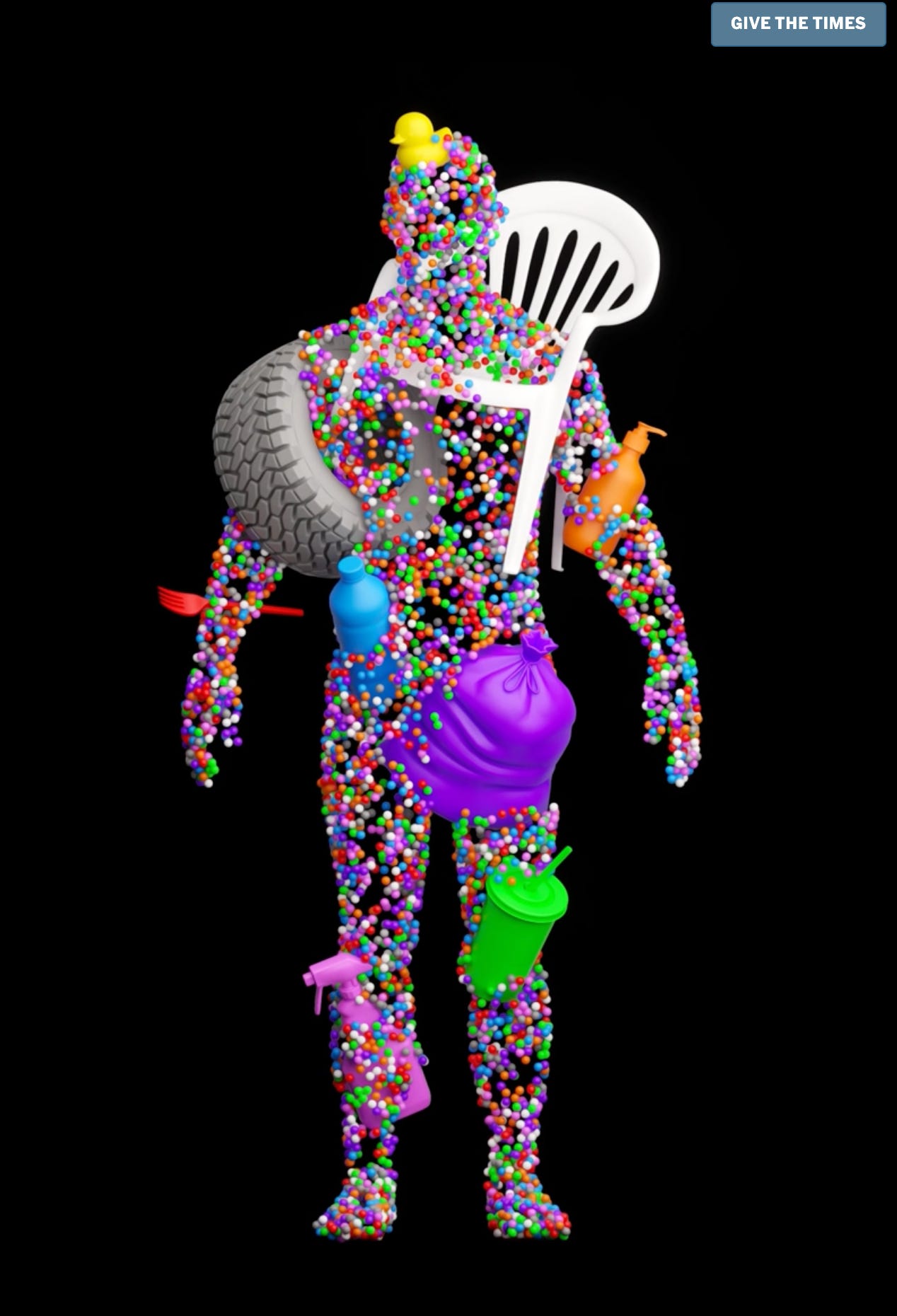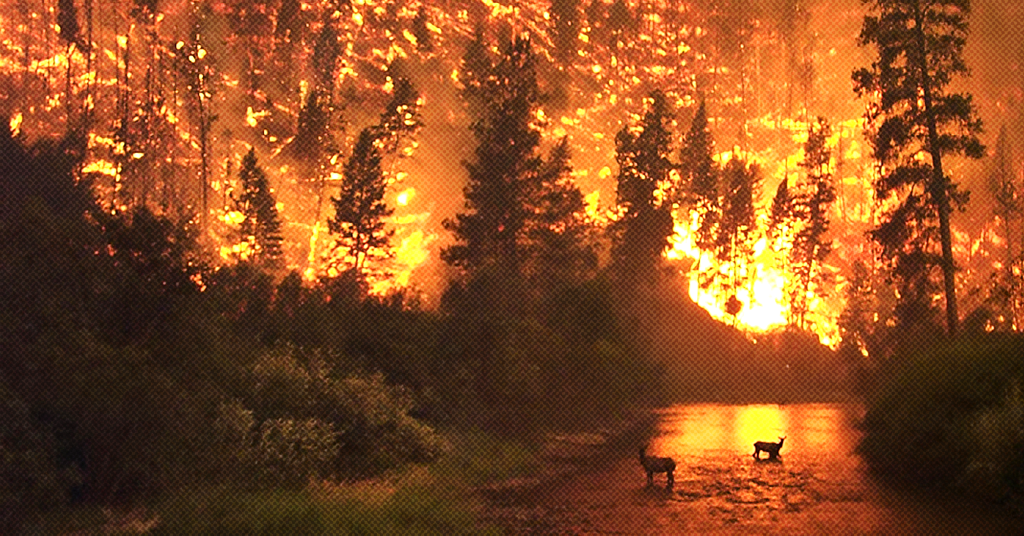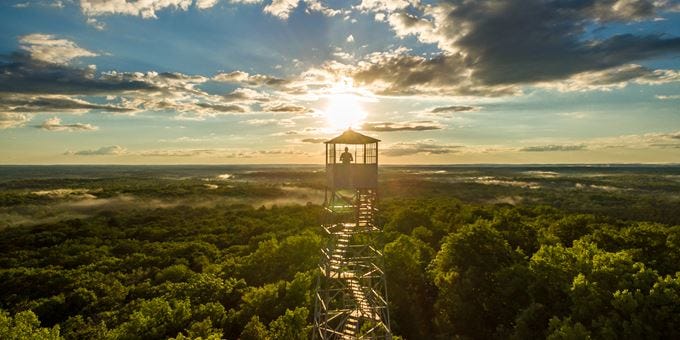Just this week, David Wallace Wells (the fella who scared the living shit out of everyone with his 2017 New York Mag article The Uninhabitable Earth) published a piece in the NYT on the pervasiveness of plastics
.
He coins the term “exposome” to note the fact that almost everywhere we look, humans, plants, animals and soils are all intertwined with the outputs and byproducts of industrial civilization.
A bunch of them originate from the “better living through chemistry” of tweaked hydrocarbons. (AKA fossil fuels).
Wallace-Wells notes:
Whole environmental movements of the past have been built on fears of incipient contamination. But what are the lessons when pollution is seemingly everywhere, and in everyone, already?
Today, it is no longer entirely rational to imagine an escape, though, reflexively, we do so anyway — entertaining fantasies of purification and paying for novel detox treatments.
But for most of us, this doesn’t seem like the kind of problem you can so easily solve — say, by discarding a worn plastic spatula or restricting your child to wood-chip playgrounds.
But the E.P.A. is looking not to extend those gains or the kinds of standards and regulations which produced them. Instead, the agency is moving backward, as rollbacks to environmental policy threaten to unleash mercury and dioxins and even lead into our mouths and lungs.
As MAHA promises less food dye, MAGA gives us more pollution, as though anyone anywhere was clamoring for it.
If anything, we are clamoring for the opposite: a cleaner and less polluted world, as MAHA, in all its confusion, reminds us.
Another lesson of universal-seeming contamination is that, while true purification of the world may be a naïve goal, reductions do matter, particularly at the point of production.
Those little numbers add up, too, and also instruct us: Environmental contagion is important not because it is possible to keep everything at bay, but precisely because we cannot.
The world is inside us, now. What are we going to do about it?
THERE IS NO AWAY
As I write this, sitting in a cabin at 10,000’ in the Rockies, we scan the mountains to our west each morning.
If we can see the distant peaks clearly, it means the half dozen or so fires burning are tamped down. If it’s layers of smokey haze, it means they’ve been getting worse overnight.
We are not alone in this.
A few summers ago I traveled with my family to the border between the United States and British Columbia.
We were heading north to visit old friends in the mountains. Part of the trip was social— our kids liked each other—but the other part was practical: We were scouting locations where we might want to move.
For over a decade we’d been hunting for the Last Best Place in North America to call home. A place with wild lands to adventure in and community to raise our kids.
Except at the border we got a scratchy voice mail from our friends. “Don’t bother coming up,” it said. “Too much smoke in the valley. We’re getting out of here until we can breathe again.”
Forest fires are a fixture of the American West, and the cooler latitudes of British Columbia offer only marginal relief from dry summers, careless campers, and lightning strikes.
But this was different. Our maple-leaf Shangri-la wasn’t even burning this time.
Sweden was!
“This year, it’s an incredible amount of burning,” said Liz Hoy, a researcher at NASA’s space flight center, “and the smoke affects air quality thousands of miles away from the Arctic region.”
Our imagined refuge just wasn’t going to cut it. Even the “early adopters” who’d planted gardens, raised barns, and forged community in that ideal spot were suddenly refugees from events sparked off halfway around the world.
There really is no “away.”
For Doomsday Preppers rejecting Ben Franklin’s advice to hang together and insisting on going it alone, the wilds of British Columbia might still seem too accessible.
They’d prefer to think that their own private Idaho or New Zealand or Hawaii might provide a more pristine refuge away from our problems. But consider the most extreme and remote places on the planet, like the north and south poles.
A team of researchers has recently discovered that microplastics— those tiny little pellets that break down from all of our waste—have found their way into arctic ice cores at nearly the same rate they show up in European towns. We’re all eating, breathing, and absorbing the stuff. Even Santa and his elves.
Even those adorable marching penguins of Antarctica.
Conditions at the highest and lowest points on Earth—Mount Everest and the Mariana Trench—aren’t much better. Trash left be- hind by climbing expeditions—empty oxygen bottles and abandoned gear—have been a sad fixture of Himalayan base camps for decades. But it’s not just climbers leaving a black mark on that mighty moun- tain.
John All, of Western Washington University, reported that his team at Nepal’s Everest base camp found pollution buried deep in the snow- pack. The samples they processed in their makeshift mountain labs were surprisingly dark with contaminants.
“There are little pieces of pollution that the snow is forming around, so the snow is actually trapping the pollution and pulling it down,” Dr. All said from Kathmandu. As alpine winds whip across the tall- est summit in the world, they’re bringing the smog of Mumbai and Shanghai with them. So much for “mountain air fresh.”
A year after the Swedish fires prompted that evacuation from Brit- ish Columbia, National Geographic published results from deep-sea expeditions into the Mariana Trench—the deepest spot on Earth.
And there, thirty-six thousand feet below sea level, a place so remote and extreme that virtually nothing can survive, a high-tech submersible snapped a photo of a discarded plastic shopping bag.
As arresting as that image is, it wasn’t a fluke. “Last February,” National Geographic reported, “a separate study showed the Mariana Trench has higher levels of overall pollution in certain regions than some of the most polluted rivers in China . . . the chemical pollutants in the trench may have come in part from the breakdown of plastic in the water column.”
We can chalk both of these examples—wildfire smoke and industrial pollution in weirdly remote places—up to two forces, the jet stream and the Gulf Stream.
We’re on a rotating planet and air and water circulate in strong and predictable currents. What starts in one place almost always ends up someplace else.
But other elements of our hyper-connectedness are new and shrinking our world whether we like it or not.
Consider air travel and the internet. Both germs and memes spread virally.
***
As far back as the Black Death in medieval Europe, scholars have traced the same wavelike pattern of epidemic infection. A virus starts in one place and ripples out at a predictable rate, limited only by the average speed of travel. In the fourteenth century, the bubonic plague hitched along the Silk Road to the seaports of Crimea and the Black Sea. The sickness then spread across Europe at roughly the rate of horse-drawn travel—about two kilometers per day.
The advent of planes, trains, and automobiles pushed that familiar wave pattern underground. Hop on a plane in Beijing and you (and any virus you were inadvertently hosting) could be in New York fourteen hours later.
Attend a conference in Boston or a political rally in London and by the time you got home and started feeling sick, thousands of participants could have carried the illness almost anywhere.
That sort of near-instantaneous teleportation confounded old models of tracking disease. But once network theorists were able to correct for these accelerated rates of transport, the algorithms began to show the familiar wave pattern of transmission again.
But there’s an even more recent contagion that’s virtual rather than physical. And it’s all made possible by the transport of ideas through fiber-optic cables and Wi-Fi signals.
To understand how viral ideas propagate and mutate, we need to examine a horrific example of global infection that makes the others seem tame—the 2012 YouTube spread of the K-pop song “Gangnam Style.”
That year, a strange, atonal, numbingly repetitive song ex- ploded in popularity, becoming the first video on YouTube to pass one billion views.
Researchers have long assumed that digital memes—whether songs, tweets, videos, or jokes—follow the same pattern of growth as biological diseases. Until recently they had no way to prove it. Trying to track that telltale viral ripple of contagion was next to impossible.
If they tried to follow the geographical trail as they had for the Black Plague, “Gangnam Style” seemed to spread randomly from ground zero in South Korea across the world. According to the old modeling, it didn’t make any sense.
“Geographic distance is not the key factor in the spread of informa- tion over social networks,” the researchers wrote in MIT’s Technology Review. “That depends instead on the strength of links from one area to another—places that have lots of social ties are likely to receive information more quickly than those that have weak ties.”
Once they were able to correct for social distance versus physical distance, they found that the route to the worldwide domination of “Gangnam Style” matched the old wave pattern perfectly.
After first getting uploaded, it hopped from South Korea to the nearby Philippines, and from there to the United States and the rest of the English- speaking world.
Google Trends and Twitter mentions of the song matched the ripple effect first noticed with the Black Death: from the speed of horseback, to the speed of airplanes, until today, when the rate of transmission is limited only by the speed of our internet routers.
“The spread of modern memes occurs in just the same way as ancient diseases,” the team noted. “So the ‘Gangnam Style’ video pandemic spread in exactly the same way as bubonic plague.
That’s not really a surprise. But it does confirm the extraordinarily deep link between the physical world and the world of pure information.”
The knock-on effects of a world shrunken by travel, satellites, and internet cables make it nearly impossible to escape from our challenges, even at the literal top, bottom, and ends of the Earth.
Pollution, fires, disease, and gratingly catchy dance memes are all only one click away.
And, as it turns out, so are Rapture ideologies. Even at the Ends of the Earth, the End of Days will find us.
So perhaps the blessing wrapped inside the curse of realizing we are fully entwined in the Athropocene Era, is that we can stop trying to evade or avoid.
We can give up hopes of “purification” or exceptionalism, and just roll up our sleeves, connect with our friends and neighbors, and do the simple but real work of tending our gardens, and keeping our eyes on the horizon.










Beautifully written. There is no "away." I actually just published an article yesterday about the toxins everywhere in our environment and our bodies. With all the talk of climate change, issues like freshwater, degrading agriculture, habitat loss, and toxic pollution don't get enough attention.
Right, the best we can do now is adopt our best Stoic or Budding Buddhist posture. Live in the moment. Enjoy the day. Plant some spuds. The collapse of civilization started almost as soon as it began thousands of years ago. Modern techno-industrial, global financialized civilization is an excellent accelerator, exponentially increasing the rate of collapse as the years go by. To riff on a riff from neoliberal rock star Bill Clinton, it's the Overshoot, stupid. But so what? We are all addicted to MTI civilization, and have been for generations. And one thing addicts have a terrible time doing is admitting they have a problem. Even those of us who are in recovery and have our fifteen-year token don't have the intestinal fortitude to revolt against the culture that formed us. We are too busy trying to feel good about ourselves. And why shouldn't we? That's a feature, not a bug. Are we not Homo sapiens? The meme thing started with the printing press, maybe? Or was it stories around the campfire? We have a lot of bloggers in the campground, and it's still pedal to the metal on Route 666 or some such thing. The United States of New Miracles, that exceptional bastion (American Acception) of freedom and democracy, created the meme of Western Civilization (The West, A New History of an Old Idea) and our predestined role as the New Rome. PAX Ameri-Bomb-U. Bounce the rubble, turn the other cheek, and look away. Point to the sky. Thank you ܝܫܘܥ. Are Americans stupid, lazy, or just addicted to bull shit? I suppose that people have been bending over and taking it for so long that they can only see the floor in front of them or the meme on the screen. The Old Normal is wearing thin as the evil empire speeds toward that proverbial cliff while it inspires the global south (whatever you call the 88% of the world population that isn't part of the New Rome) to use it all up, but with less bombing. Viral Empire has conditioned the whole wide world to want a piece of it. Don't expect China to save you with Green this and that; the coal required alone is the foot on the accelerator in cement knock-off Nikes. America Strong! Focus on sports, entertainment, and shopping 🛍, or take some workshops and improve your self-esteem. Become a Mevangelical. The Lord, with his army of CEOs, will usher Yankees to heaven after the Rapture, or to your favorite Crypto City State run by one of God's Zero-to-One CEOs. Our comfort food is lies. Some innovative entrepreneur will probably make a pill for our mentalholic syndrome. The Nootropics don't seem to be working, or maybe it's only because the plebs and proles can't afford them. Neurohormones are just metaphors now. And due to the tariffs or some such other factors caused by the "symptom," also known as President Donald J. Trump, our Japanese plastic display of the Mediterranean Diet has become unaffordable. Damn, so many people were working up the courage to try that diet, and after so many airport best sellers. Once they get their community gardens planted and learn how to fish, they'll be back on track to installing that plastic fork in their brains. We are nothing if not true believers and mimics. Tell folks a story, and make them believe it, and the bandwagon drives on. Circumstances, that could-not-care-less dictator will decide what we do next, and after the panic subsides for a spell, we can pin a medal of valor on ourselves for being a part of it all. There, Jamie, you gorgeous man you, word salad. It's not an exclusive thing. (By the way, I got that "intestinal fortitude" expression from Rosenberry at Denver Country Day school, and I used to hunt elk at the Bear Ranch with Jimmy and Buddy Bear way before the Koch brothers bought it and turned it into a Dude Ranch. I'm afraid to go back and visit, I don't want to spoil my memories. I miss the views from the Western Slope, the trout, and the spuds in the fire on a high-altitude stalk with a packhorse.)